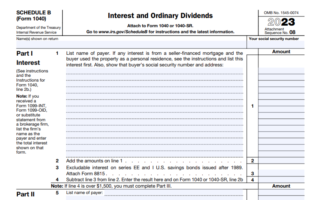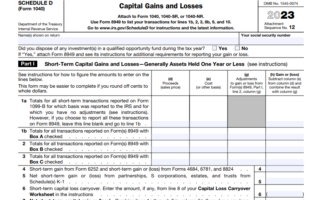IRS Schedule L, a lesser-known but crucial component of various tax forms such as 990, 1120s, and 1065, often raises questions and concerns among taxpayers. This article aims to unravel the mysteries surrounding Schedule L by providing a comprehensive guide. We will break down what Schedule L is, why it matters, and how to correctly fill it out, addressing common pitfalls along the way.
What is Schedule L and Why Do You Need It?
IRS Schedule L, officially titled “Schedule L- Balance Sheets per Books,” is a supplementary schedule that provides detailed information about an entity’s financial position at the beginning and end of the tax year. It is an integral part of various tax forms, including Form 990 schedule L for tax-exempt organizations, Form 1120s for S corporations, and Form 1065 for partnerships.
While not all corporations are obligated to submit a balance sheet, it’s worth noting that many smaller corporations may not find the need to complete Schedule L. Nevertheless, in cases where a corporation is mandated to include a balance sheet with their tax return, the utmost importance lies in providing a precise and coherent balance sheet that aligns with the other details reported on the special section of the tax return.
Why Do You Need Schedule L?
Schedule L serves several critical purposes:
- Verification of Financial Accuracy: The IRS uses Schedule L to verify the accuracy of the financial information reported on the respective tax return forms.
- Transparency: It offers transparency into an entity’s financial health, ensuring that stakeholders and the IRS can assess its fiscal stability.
- Tax Compliance: Filling out Schedule L accurately is crucial for tax compliance. Errors or omissions can lead to penalties or additional scrutiny from the IRS.
Completing Schedule L: Instructions for Form 990 Schedule L and More
Filling out Schedule L correctly is essential to avoid complications during the tax filing process. Here’s a step-by-step guide on how to complete a balance sheet of Schedule L:
| Step 1 | Gather Financial Statements |
| Before you begin, collect your financial statements for the beginning and end of the tax year. This includes your account balance sheet, income statement, and cash flow statement. | |
| Step 2 | Locate the Schedule L Section in Your Tax Form |
| Depending on your entity type, you’ll find Schedule L in Form 990, 1120 s, or 1065. It is typically located in the “Balance Sheets” section in form or a similar area. | |
| Step 3 | Enter Beginning and Ending Balance Amounts |
| In the appropriate sections of Schedule L, enter the beginning and ending balance amounts for various categories such as assets, liabilities, and net assets. Make sure these figures match the data from your financial statements. | |
| Step 4 | Reconcile Balance Sheet Items |
| Ensure that the balance sheet items on Schedule L are consistent with those reported in the books of your organization. Any discrepancies should be reconciled on Schedule M-1 or Schedule M-2, as necessary. | |
| Step 5 | Review and Double-Check |
| Thoroughly review your completed Schedule L to verify that all information is accurate and matches your financial statements. Any inconsistencies can trigger IRS inquiries. |
Common Pitfalls in Filling Out Schedule L
Avoiding common pitfalls is crucial to ensure your Schedule L is accurate and IRS-compliant. Here are some potential pitfalls and how to resolve them:
Pitfall 1: Inaccurate Beginning and Ending Balance Amounts
Solution: Double-check your financial statements and ensure that the beginning and ending balance amounts accurately reflect your organization’s financial position.
Pitfall 2: Inconsistent Balance Sheet Items
Solution: Reconcile any inconsistencies between your Schedule L balance sheet items and your organization’s books. Make any necessary adjustments on Schedule M-1 or Schedule M-2.
Pitfall 3: Missing Information
Solution: Ensure that all required information is included on Schedule L. Missing data can lead to IRS inquiries or penalties.
Pitfall 4: Failure to Reconcile Differences
Solution: If you encounter differences between the balance sheet on Schedule L and your organization’s books, address them promptly and provide explanations as needed.
5. Frequently Asked Questions About Schedule L
To further clarify the intricacies of IRS Schedule L, let’s address some frequently asked questions:
Q1: When is Schedule L used?
Schedule L is used by organizations that file Form 990, Form 1120s, or Form 1065 to provide detailed balance sheet information to the IRS.
Q2: How can I ensure the accuracy of my balance sheet on Schedule L?
To ensure accuracy, reconcile your Schedule L balance sheet items with your organization’s books. Any discrepancies should be addressed and explained in Schedule M-1 or Schedule M-2.
Q3: Can I file Form 990 or Form 1120s without completing Schedule L?
No, if your organization is required to complete Schedule L, you must include it with your tax return. Failing to do so can result in non-compliance.
Q4: What should I do if I’ve reported an incorrect amount on Form 990 or Form 1120s?
If you discover an error on your tax return after filing, you can file an amended return to correct the mistake. Be sure to provide an explanation for the changes.
6. Conclusion: The Importance of Accurate Filing Schedule L
In the intricate world of tax filing, Schedule L often remains a puzzle for many. However, understanding its purpose and how to complete it accurately is crucial for tax compliance and financial transparency. By following the steps outlined in this guide and avoiding common pitfalls, you can ensure that your Schedule L is error-free and contributes to a smooth tax filing process.
Remember, accuracy and transparency in financial reporting not only keep you in compliance with IRS regulations but also build trust with stakeholders and help you make informed financial decisions. So, the next time you encounter IRS Schedule L, you’ll be well-prepared to navigate its complexities with confidence.
Summary of Key Takeaways:
- IRS Schedule L is a crucial component of tax forms like 990, 1120s, and 1065.
- It provides a detailed balance sheet at the beginning and end of the tax year.
- Accurate reporting and following instruction on Schedule L is essential for tax compliance and financial transparency.
- Common pitfalls include inaccurate balance amounts and inconsistent balance sheet items.
- Address discrepancies promptly and provide explanations when necessary.
- Understand the importance of Schedule L in financial reporting and tax compliance.





